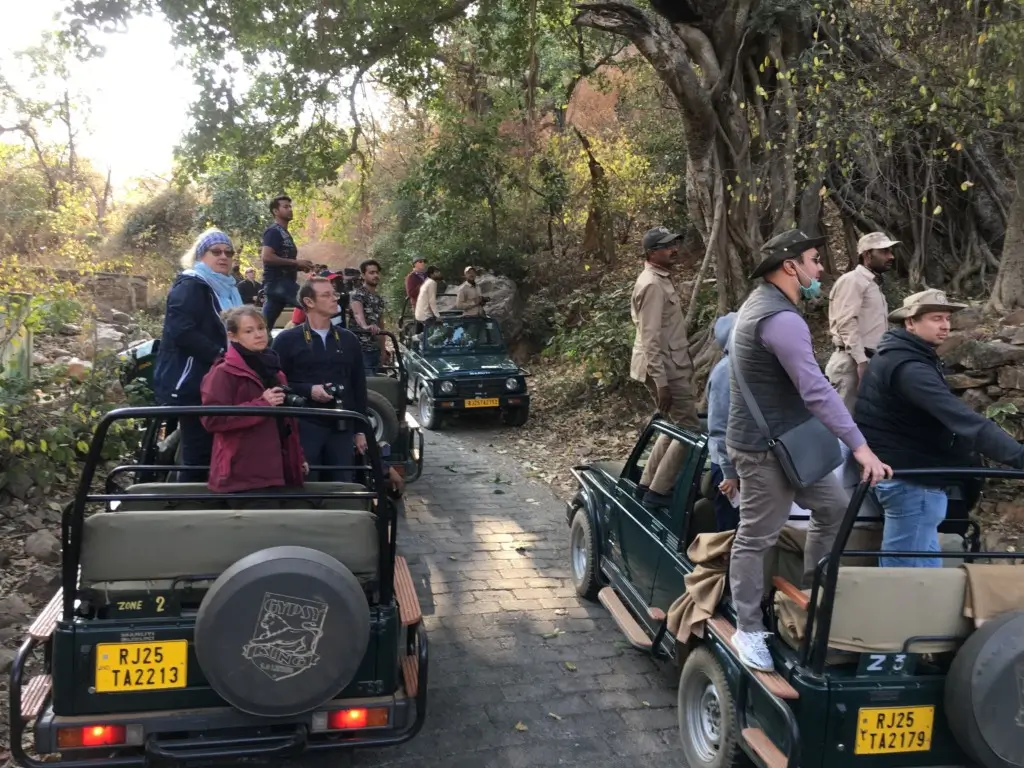
My husband and I recently returned from a trip to India, a captivating place that is an explosion of vivid sights, sounds and smells. From the Taj Mahal and tuk-tuks (think motorized rickshaws), to saris, Bollywood and curry, there is only one India.
I had the privilege of speaking at leadership events in both New Delhi and Mumbai. Through these experiences, I gained a much fuller understanding of the economic opportunities India enjoys. I came away inspired by the accomplishments of the business leaders I met and warmed by the friendships I gained.
Travel can be a great teacher, and this trip was no exception. Yet some of the most powerful leadership lessons from this trip came in the most unexpected of places – while walking through the ancient palaces of the maharajas, meeting a 10-year-old magician in a rural village, and looking for tigers in the underbrush of the Vindhya plateau.
This is part one in a series on lessons I learned during this journey. I hope you learn as much from it as I did. Let’s start in the wild, which actually has some striking similarities to the workplace.
Tigers are beautiful and rare creatures. The Bengal tiger is the national animal of India and can still be seen in the wild, thanks in large part to Project Tiger, a conservation program launched by the Indian government nearly 50 years ago to protect the animals from extinction.
We saw three tigers during a two-day visit to Ranthambhore National Park, a 108-square mile tiger preserve that is also home to crocodiles, leopards, peacocks and a variety of other wildlife. It was a thrilling experience to see a tiger up close – and I mean very close — in its natural habitat. On two different occasions, a tiger walked right in front of our jeep.
Tigers are the largest members of the cat family. They are predators at the top of the food chain, hunting deer, wild boar and monkeys, among many other things. Tigers are stealthy, camouflaging themselves in tall grass while they stalk prey. They are also incredibly beautiful and sleek, moving with a grace and calmness that can lull you into overlooking the danger at hand.
But spotting a tiger in the national parks is no easy task. Some visitors don’t see one until their fifth or sixth visit. Experienced guides and drivers who know the park well are your best bet, not just for their knowledge of the terrain, but because they have learned a secret that also holds many powerful leadership lessons.
Our group had hired just such experts, and we set out just before sunrise on our first safari. My husband, a friend and I rode together in one jeep; our traveling companions in another. Each vehicle was assigned a guide and a driver.
It was very chilly as we started out, and the road was bumpy and dusty. Our guide seemed quite knowledgeable and told us many interesting facts about tigers, their history and the country’s preservation program as we approached the entrance to the park.
Once we passed the guard station, we headed for the zone we had been assigned to for the morning and began our search. We drove up and down hills, passed several watering holes, and stopped to birdwatch a bit. We saw peacocks, deer, two crocodiles and a mongoose.
But no tiger.
On several occasions, our guide instructed our driver to simply stop and turn the engine off. And we just sat. The first time or two he did this, I was frustrated. I didn’t understand – why are we sitting? The other animals are beautiful, but we came to see a tiger. Shouldn’t we be driving around? Shouldn’t we try to cover more ground to increase our chances? Why would we stop and do nothing?
It didn’t take long for our guide to notice our confusion. You can drive and drive in hopes of seeing a tiger, he explained, but this obvious strategy often wastes time and energy, and it ultimately tries the patience of the team. You’re also making unnecessary noise, kicking up dust and, most importantly, racing by the very clues you need.
Your best bet, he said, is to stop, watch and listen.
When a tiger is on the move, he told us, other animals are the first to notice and they give a call about the approaching danger. Sometimes their alarm is very noticeable, like a monkey’s shriek while it climbs frantically into the tree tops. Other warnings are subtler, such as a bird’s cry made at a slightly higher pitch, or a Sambar deer’s short quick bark twice in succession as it turns to run.
The calls can be right in front of you, or far away. If you’re not watching and listening carefully, you’ll miss them.
It sounded like a plausible reason for the sit-and-wait strategy, but, I’ll admit, it was a little hard to buy into this approach. While the minutes ticked by, I couldn’t help but think we should get moving, try to cover more ground and move into more open spaces to increase our line of sight. Do something – anything – seemed like a more productive strategy and one more in tuned with my destination instincts.
But the effectiveness of his approach was proven in dramatic fashion. After riding around for some time, our guide instructed our driver to slow way down, and he leaned out of the jeep. On the side of the road, he spotted fresh tiger prints in the dust. Once we got close enough to them, they were unmistakable.
We followed the prints along the road until they disappeared, then drove a bit until we reached a low spot near a dried creek bed, trees thick on either side. The guide instructed our driver to turn off the engine. We sat and waited. Other jeeps and guides had gathered nearby as well. No one said a word.
And then we heard it – the animals gave their calls. The treetops came alive as monkeys began swinging wildly from the branches and chattering loudly. Birds flew from the trees, calling out. The boss was on the move. Where exactly and moving in what direction was anyone’s guess. But we knew something big was about to happen.
My heart was in my throat. The anticipation of a sighting was absolutely thrilling.
Our guide spoke swiftly and pointed to where he wanted our jeep to be positioned. The driver threw the vehicle into reverse and quickly backed down the road to an opening in the woods. It was clear our guide was relying on his instincts and 20-plus years of experience at that critical moment to anticipate where the tiger might emerge.
And, in fact, she did, in all her glory, right beside us. I captured priceless video of her jumping effortlessly over a rock wall and sauntering into the clearing, turning around just long enough to cast a curious glance at her audience. Simply amazing.
Needless to say, we were beside ourselves with excitement and couldn’t stop talking and looking at pictures (and video) while we drove back to our camp.
It wasn’t until later in the day when the excitement had died down and I could think more deeply about the experience that the lessons came home to me. While luck and timing played a part, as is always the case, there were several reasons for our success that we can apply to our own leadership journeys.
Here are three.
Our guide was experienced and knew the warning signs, both subtle and overt. He knew how they could help inform our process and improve our chances. If he hadn’t, we would have been like many of the vehicles we saw wandering aimlessly around the park whose guide seemed too busy with the “cover more ground” strategy.
How many times have you been unaware of — or simply ignored — warning signs that could have helped you anticipate problems? It could be something as subtle as a slight change in the attitude of a trusted teammate. Or an off-hand comment made by a colleague. It could be as overt as competing interests among colleagues that start derailing an important project. Or a top contributor deciding to leave for another job with no real apparent reason.
If you’re paying attention, these signs can alert you that something bigger is brewing. But you must learn to identify and recognize the signs, or you can run straight into trouble that is far more difficult to recover from.
Although we covered a lot of ground and looked in likely places, our guide resisted the temptation (and subtle pressure from us) to spend all our time driving around in hopes that we would simply run into a tiger. If we had used that strategy, we would have missed at least two of the tiger sightings we had.
Destination leaders often go full throttle in pursuit of their goals, and sometimes our drive pays off. Other times, we can become so single-minded in our focus that we pay little to no attention to anything or anyone around us when that’s exactly what we need to do.
Have you found yourself thinking you were too busy to have meaningful conversations? You missed a breakdown happening right in front of you because you were looking past it? You were so committed to your own strategy that you weren’t willing to stop and consider someone else’s approach that could have led to a better result? You gave in to pressure from others to deviate from a strategy that you believed would be more effective?
How much better could you lead if you tried a “stop, watch and listen” strategy every now and then? Here’s what that could look like:
Our guide was adept at watching and listening, but he also knew how to use that information to his advantage. He gambled on where to park our jeep by watching the direction the animals were moving and relying on his instincts and experience.
You will never know exactly what to do every time. No leader does. A difficult situation arises suddenly, things begin to unfold in real time, and a decision must be made quickly. It can be scary, especially if the stakes are high.
You can improve your chances of making better decisions at critical moments, however, as you become more adept at assessing situations and applying insights. Among other things, this requires you to:
Making decisions at critical moments takes practice. But if you are more intentional about your overall decision-making process, you’ll find it comes easier in pressure-packed situations. And you’ll likely enjoy more satisfactory outcomes.
I hope these three leadership lessons help you lead at your best. More to come on lessons learned from maharajas, maharanis and a 10-year-old magician.
Are you looking for guidance as you navigate the entrepreneur's journey, or step into a leadership role? Elise Mitchell has been in your shoes. With over 20 years experience in an executive role, her career has transitioned into leadership development, executive coaching, and keynote speaking. Learn from her practical strategies and get ready to implement guides that willl tranform your leadership, today.
Copyright (c) 2023 Velocity Collective, LLC. All rights reserved.



